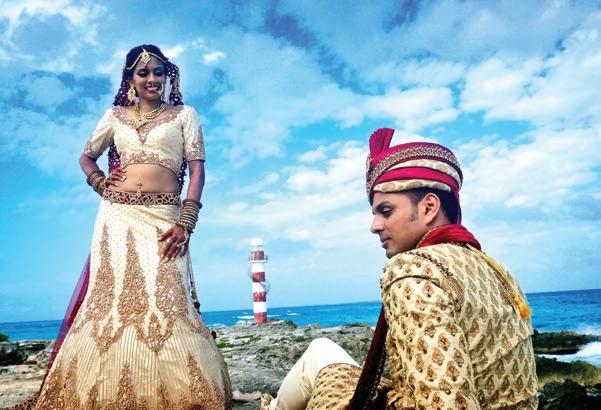
4 minute read
Connexion culturelle
Par Doug Wallace
Adoptez des traditions qui unissent : donnez à votre cérémonie de mariage une touche de symbolisme romantique en y incorporant un élément lié à votre héritage culturel.
Advertisement
Cultural Connection
By Doug Wallace
Embrace the family ties that bind. Add a dash of romantic symbolism to your wedding ceremony by incorporating a tradition that speaks to your cultural roots.
© SANDOS CARACOL
PROMENADE À L’ÉCOSSAISE
Contrairement à certaines cultures où seul le couple descend l’allée, la tradition écossaise veut que la parade nuptiale inclue tous les invités, précédés par un cornemuseur ou un violoniste. Cette coutume formelle est marquée par plusieurs superstitions : le marié doit mener le bal aux côtés de la demoiselle d’honneur suivis par la mariée accompagnée du garçon d’honneur et la procession doit croiser le chemin de deux cours d’eau pour s’attirer la chance.
FORTUNE ESPAGNOLE
En Espagne, la tradition de l’arras, selon laquelle le marié devait autrefois offrir des pièces de monnaie à la mariée en gage de soutien financier, veut aujourd’hui que ce soient plutôt les deux membres du couple qui se fassent cette promesse en s’échangeant 13 de ces pièces. Une autre coutume reliée à l’argent veut que la cravate du marié soit coupée en morceau et vendue en enchère aux invités pour amasser des fonds destinés aux tourtereaux.
UNION IRLANDAISE
En Irlande, les poignets des amoureux sont attachés ensemble avec un ruban pour symboliser leur union. À la base, cette tradition celte marquait une union qui amènerait le couple à cohabiter pendant un an pour tester sa compatibilité. Si l’expérience était un succès, la cérémonie de mariage pouvait avoir lieu.
SOUHAITS NÉERLANDAIS
Aux Pays-Bas, les invités peuvent écrire un message sur de petits papiers qui sont lus par les mariés puis accrochés avec un ruban à un arbre à souhait placé près de la table d’honneur. Aujourd’hui, les couples peuvent choisir d’utiliser de vraies branches ou encore un arbre en papier, en guirlande de lumière ou en tiges de cristal. Cette tradition est une alternative intéressante au livre des invités puisque les mariés peuvent ensuite insérer les souhaits dans un album.
GUIRLANDES INDIENNES
La cérémonie du jaimala ou varmala est une tradition ancienne hindouiste qui veut que le couple s’échange des guirlandes de fleurs. Ce geste symbolise la reconnaissance et le respect de l’autre ainsi que l’union des deux familles – un mariage de valeurs et de coutumes. Les fleurs les plus utilisées sont la rose, le jasmin et le souci, dont les couleurs varient pour s’agencer aux habits du cortège de la mariée.
SYMBOLISME MAYA
Les couples peuvent ajouter une touche spirituelle et culturelle à leur mariage sur la côte est du Mexique dans le cadre d’une cérémonie maya non religieuse. Le shaman qui accomplit le rituel invoque l’énergie des quatre éléments — la terre, l’eau, le feu et l’air — pour qu’ils renforcent l’amour du couple. La cérémonie peut se dérouler dans la forêt tropicale, proche d'un cénote sacré ou sur la plage. L’encens purifie la scène qui vibre au son des percussions, des flûtes et des pas de danse. SCOTTISH STROLLING
Many cultures involve the happy couple walking down an aisle or along a pathway; but, in Scotland, the whole wedding party takes the Wedding Walk together to the church, preceded by a bagpiper or fiddler. Though this “march” is a formal tradition, there are whimsical elements: the groom leads the maid of honour with the best man escorting the bride, and it is considered good luck for the procession to cross running water twice along the way. SPANISH FORTUNE
In Spain, a custom called arras once saw the groom giving the bride coins, signifying a promise to support her. This tradition has been updated, with the couple now exchanging 13 coins to show that they will both support the marriage financially. One other monetary convention involves the groom’s tie being cut into pieces and auctioned off to guests to raise funds for the new couple. IRISH UNITY
The wrists of the bride and groom are tied together with twine in Ireland, a Celtic tradition called handfasting that symbolizes unity. It springs from a tradition wherein a couple was “bound” together for a year to test their compatibility, after which the marriage took place – or not. This ancient bond of wedlock is believed to be the origin of the phrase “tying the knot.” DUTCH WISHES
A Wishing Tree is set up near the bride and groom’s table at receptions in the Netherlands, along with paper leaves on which guests write their well-wishes. Newlyweds read out the notes and tie them to the tree with ribbon. Real branches, paper trees, twinkling lights or crystal strands – the art direction is open to interpretation. The Wishing Tree is a great alternative to a guest book and the leaves can later be added to a scrapbook. INDIAN GARLANDS
The jaimala or varmala ceremony is an ancient Hindu wedding tradition that features the bride and groom exchanging garlands of flowers. It symbolizes both an acceptance and respect of one another as well as the union of the two families, a merging of values and customs. Roses, jasmine, and marigolds are the typical flowers used, with colours varying to suit the bridal party attire. MAYAN SYMBOLISM
Couples can add a spiritual and cultural experience to their wedding ceremony on Mexico’s east coastline with a sacred, non-religious Mayan ritual. It involves a shaman calling on the four elements – earth, water, fire, and air – to focus their energies on the bride and groom to help strengthen their love. The ceremony can be conducted in the rainforest, near a sacred cenote or on the beach. Incense purifies the setting, which is augmented with drums, flutes, and dancing.










